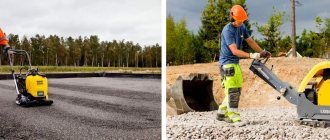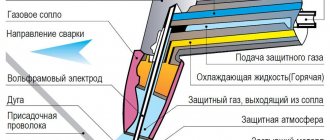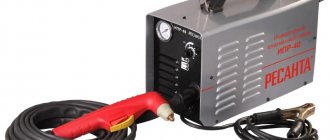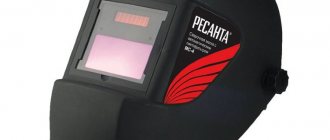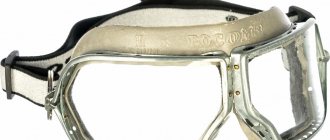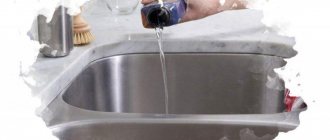Design and principle of operation of a manual riveter
This tool belongs to the category of hand-held devices. Its main purpose is to connect two metal workpieces, the thickness of which does not exceed 10 mm. This is a one-piece type of fastener, used primarily for assembling sheet metal structures. It provides access to both work areas at the same time. There is no need for additional support.
The riveter has a simple device, including:
- a handle driven by the operator's physical strength;
- a head on which the consumable element is attached;
- clamping mechanism.
There are two types of clamping mechanism: threaded and pull-out.
The operating principle of the device is based on creating a through hole with the subsequent installation of rivets. This method of joining metal sheets is advisable to use in cases where it is not possible to use a threaded or welded connection.
In addition to manual riveters, there are electric, battery-powered and pneumatic tools. Despite this variety, the manual type is most popular due to its simple design and the absence of the need to use additional equipment.
The riveter's work process involves the operator first making holes for the fastener to enter. After this, the working part of the tool is brought to the mark, and the rivet is installed by pressing the handle.
Using the tool in question, roofing work, pipe installation, fixing corners, etc. are performed. Such connections are considered durable and vibration-resistant. They never burst like weld seams. Compared to screw fastenings, riveting is more cost effective.
Advantages of riveters
The use of riveters has the following important advantages:
- Easy to use.
- Reliability of fastening and connection.
- There is a possibility of fastening in hard-to-reach places.
- Resistance of fastenings to overloads and vibrations.
- Riveters can be used in many areas of construction, repair or household work.
- High performance connecting fasteners.
- Low price of this tool.
Due to these advantages, it is often used in construction and households.
How to choose a manual riveter for your home
The following criteria will help you decide on the choice of riveter model.
The most honest review of riveters!
Manufacturer
Experts advise giving preference to tools from well-known manufacturers. It is worth taking a closer look at the products of these brands:
- Kraftool;
- BISON;
- Biber;
- STAYER;
- GROSS;
- Matrix;
- LEOPARD.
By design
Riveters are classified according to different criteria. One of them is design features. The following options are available for sale.
Classical
It is also called standard. There are two types:
- threaded - provides fastening of parts using bushings, a large compression force is required (a large load is placed on the consumables);
- exhaust - forms a quick connection with minimal effort.
The purpose of the tool is determined by the type of fasteners used:
- threaded - for riveting threaded rivets;
- exhaust – for exhaust consumables.
Riveter BLACK HORN adjustable
Perestavnaya
Another name for the device is a two-position riveter. He received it because of the ability to change the position of the head. It can be set to 90 degree and 180 degree mode. Slopes are determined by the relation of the assembly to the body. Switching modes is performed without the use of an additional tool.
FIT rotary riveter
Turning
This type of design is used for working in hard-to-reach places. The working unit provides access to the two parts being connected due to the ability of the working unit to rotate 360 degrees.
Riveter TUNDRA lever-folding Basic reinforced
Lever-folding
The body of this type of instrument has the appearance of an accordion. Thanks to the folding system, the required force is significantly reduced. The accordion contracts when pressing on the handle.
AIRPRO – electric riveter
Electric
This type of tool is superior to mechanical analogues in performance. Almost no effort is required to install the rivets. The riveters operate from mains or batteries. In the first case, the device is connected to a 220 V network. The advantages of the second are mobility and the ability to work in field conditions where there are no power grids.
Reinforced
This is a professional device that has a durable die-cast housing. Thanks to its integrity, high resistance to heavy loads is achieved.
Threaded rivet
Aluminum blind rivet
Rivet type
The rivets that the tool in question works with come in different types. Among the common options:
- exhaust - consist of two parts, during installation they do not require fixation on the back side of the seam;
- threaded - used primarily for connecting thin-walled parts, the inner part has a thread, the outer part has a notch that prevents rotation around an axis;
- molly dowels – used for fastening materials with voids and low load-bearing capacity.
When choosing a riveting device, it is important to know what types of hardware a particular model can work with.
Rivet diameter
When choosing a particular model, you need to carefully study the technical description regarding the capabilities of the tool. Depending on what attachments the device is equipped with, the scope of its application is determined. A good riveter is capable of working with fasteners with a diameter of:
- 2,4;
- 3,2;
- 4;
- 4,8.
Some models have a select range of diameters.
What are rivets made of?
In addition to the diameter, you should consider what types of fasteners the tool can handle. The determining factor is the material from which the rivets are made:
- aluminum;
- copper;
- nylon;
- stainless steel;
- plastic.
A high-quality device works with almost all of the options listed. There are models that are only suitable for use with aluminum or steel products.
Rating of the best riveters for 2021
The rating of quality products will help answer the question: which is the best tool to buy for the home and how much the best models cost. The review presents popular tool models based on customer reviews and the opinions of professionals.
Riveter Kraftool 31170-H6
Classic design for blind rivets. Suitable for rods with diameters: 2.4 mm, 3.2 mm, 4 mm, 4.8 mm, made of steel, aluminum and stainless steel. The package includes: a case, a set of coupling rods in the amount of 60 pieces, various attachments and an adjustable key for changing them 10 mm. The handle body material is made of rubber and plastic. Average price: 1000 rubles.
Riveter Kraftool 31170-H6
Advantages:
- large set of nozzles;
- ability to work with 4 types of rivets;
- convenient storage;
- low price;
- famous brand.
Flaws:
- plastic handles.
Riveter STANLEY MR55 0-69-804
Used to work with blind rivets with diameters: 3 mm, 4 mm, 5 mm, 2 mm. The material of the rods should be made of copper, steel, ordinary and stainless steel, aluminum. The kit includes a wrench and attachments. Instrument dimensions – 26 cm, weight 0.63 kg. Additional information from the manufacturer: finger stops; clamp for fixing handles; spring loaded handle. Average price: 800 rubles.
Riveter STANLEY MR55 0-69-804
Advantages:
- popular brand;
- does not require much effort;
- small-sized and lightweight;
- easy to use;
- safe
- low price.
Flaws:
- There is no case for storing tools and attachments.
Riveter Gross 40401
A classic type of tool that produces clutches of rivets with a diameter of 2.4 mm, 3.2 mm, 4.8 mm. Material from which rivets are made: various types of steel and aluminum. The kit includes a wrench and attachments. The tool handles are made of plastic. The length of the device is 28.5 cm, weight is 0.6 kilograms. Cast body with stamped steel lever. Average price: 1200 rubles.
Riveter Gross 40401
Advantages:
- high performance;
- easy;
- intended for home use.
Flaws:
- no case for collecting tools;
- overpriced;
- plastic handles.
Riveter TOPEX 43E707
The tool is suitable for rivets with a diameter of 2.4 to 4.8 mm made of aluminum. Type of rivets: blind rivets. The kit includes 4 tips, an open-end wrench. Weight: 0.48 kg, dimensions: 40*125*325 mm. Average price: 500 rubles.
Riveter TOPEX 43E707
Advantages:
- large lever stroke;
- easy to use;
- suitable for home use;
- low price.
Flaws:
- no case;
- low-functional.
Cast riveter Yato “CrMo”
The cast riveter “Yato” is made of CrV tool steel and is used for steel and aluminum rivets. Dimensions 200 mm. Engages rivets ranging in size from 2.4 to 4.8 mm. Average price: 1400 rubles.
Cast riveter Yato “CrMo”
Advantages:
- easy to operate;
- light and small-sized;
- does its job;
- comfortable in the hand.
Flaws:
- overcharge.
Riveter HASKYY HBNZ-17
Tool design: lever-folding type. Type of rivets: threaded. Material from which the rods are made: aluminum, steel. The set includes 150 pieces of nozzles, rivets for all types of nozzles, a key, and a storage case. Instrument dimensions: 34 cm, weight 3.5 kg. Additional information from the manufacturer: the riveter kit includes: nozzles for rivets M5-M6-M8-M10-M12, 150 threaded rivets of 30 pcs. five sizes; plastic case. Average price: 3700 rubles.
Riveter HASKYY HBNZ-17
Advantages:
- high-quality assembly;
- easy to use;
- container for tools and attachments;
- reinforced body;
- the price corresponds to the functionality.
Flaws:
- heavy.
How to use a riveter
The riveting process begins with surface preparation. It needs to be leveled so that when installing the fasteners, the planes fit snugly against each other.
What is the RIVETER capable of and how to use it?
Before working with a riveter, you should make holes. Their diameter is determined taking into account the parameters of the fastening elements. The indicator should be 0.3-0.5 mm higher than the cross-section of the rivets. When properly installed, the fixing skirt fits tightly to the metal surface in the area of the hole.
The riveting process using a manual riveter is performed in the following order:
- select a nozzle of the required diameter from the set that comes with the tool;
- connect the working parts so that the through holes coincide;
- install the fastener into the hole with a part with a large diameter;
- install the wire from the rivet into the head, bringing it all the way;
- press the handle (at this time there is a displacement of the wire towards the main part of the fastener, which leads to its expansion);
- cutting the remaining wire, performed spontaneously during the reverse movement of the lever.
All that remains is to check the connection for strength.
Features of choosing a riveter
When choosing a tool, they rely on many important factors:
Purpose of use. This is one of the main criteria for choosing a tool that you need to pay close attention to.
- Professional. In this case, you should choose a wide-profile device with a wide variety of rivet types.
- More budget options are suitable for home use. They work with the most common types of attachments.
Design. Based on this, there are two main options:
- One-handed. The devices are very compact and easy to use, but when working, a person has to put increased pressure on the tool and at the same time his hands get quite tired.
- Two-handed devices are more efficient. After all, with their help you can create quite a lot of pressure.
The device may include additional attachments. Also, quite often the tool comes with a wrench and a shockproof case.
Selection criteria for manual rivet installers
So, if you need to choose a manual riveter, pay attention to the following parameters:
- The type of fasteners with which the unit works (screw, pull-out, piston (eyelets), universal - which installs all types of rivets).
- Maximum and minimum rivet sizes.
- Number of nozzles for rivets.
- The fastener material with which the tool works (steel, aluminum or only copper and brass).
- What is the instrument itself made of? Better - stainless steel or aluminum alloys.
Screw-type manual riveter: pay attention to the dimensions of the fasteners that can be installed
Another thing to pay attention to is the handles. The rubber pads on them should be made of good rubber. The handles themselves should be comfortable for you, so you can work faster and longer. Also pay attention to the possibility of fixing the handles when not in use - there is a special wire loop that holds the handles together. This is convenient and important when storing.



